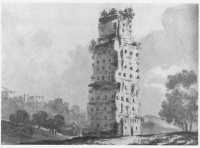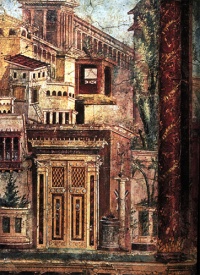Pompeii
From The Art and Popular Culture Encyclopedia
| Revision as of 19:06, 29 July 2010 Jahsonic (Talk | contribs) ← Previous diff |
Current revision Jahsonic (Talk | contribs) |
||
| Line 1: | Line 1: | ||
| - | [[Image:Aphrodite from Pompeii.jpg|thumb|200px|[[Aphrodite]] of [[Pompeii]] by [[unknown]]]] | + | [[Image:Eruption of Vesuvius (Turner).jpg|thumb|left|200px|''[[Vesuvius in Eruption (William Turner)|Vesuvius in Eruption]]'' (1817-20) by William Turner]] |
| - | + | {| class="toccolours" style="float: left; margin-left: 1em; margin-right: 2em; font-size: 85%; background:#c6dbf7; color:black; width:30em; max-width: 40%;" cellspacing="5" | |
| - | [[Image:Tomb of Pompeii by Jean-Baptiste Tierce.jpg|thumb|200px|[[Tomb]] of [[Pompeii]] by [[Jean-Baptiste Tierce]], [[1766]]]] | + | | style="text-align: left;" | |
| - | {{Template}} | + | "[[Classical archaeology]] the excavation and analysis of ancient Greek and Roman sites was born on Wednesday, [[October 22]], [[1738]]. It was on that day, a Wednesday, that an engineer in the army of the Bourbon royal family in Naples, named [[Roque Joaquín de Alcubierre]] (1702-1780), had himself lowered by ropes, down a great square well shaft, cut through volcanic material that had formed on the great volcano."--Sholem Stein |
| - | :''[[excavations of Pompeii, Herculaneum, and Stabiae]]'' | + | <hr> |
| - | '''Pompeii''' is a ruined [[Ancient Rome|Roman]] city near modern [[Naples]] in the [[Italy|Italian]] region of [[Campania]], in the territory of the [[comune]] of [[Pompei]]. | + | "At length, in 1748, in the reign of [[Charles III of Spain|Charles III]], the first Bourbon king of Naples, a Spanish colonel of engineers, named [[Roque Joaquín de Alcubierre |Don Rocco Alcubierre]], was employed to examine the subterranean canal before mentioned; and having heard from the inhabitants of [[Torre Annunziata]] that the remains of a house, with ancient statues and other objects, had been discovered at a distance of about two miles, he was led to conjecture that some ancient city lay buried there, overwhelmed by [[the great eruption of Vesuvius in 79]]. The discovery of [[Herculaneum]] early in the 18th century had now drawn the attention of the learned and scientific world to this subject. Colonel Alcubierre obtained permission to undertake some excavations at the spot where the ruined house had been discovered, and early in April, 1748, he commenced his researches, in the street afterwards called the Strada della Fortuna."--''[[Pompeii, its History, Buildings and Antiquities]]'' (1867) by Thomas Henry Dyer |
| - | It, along with [[Herculaneum]] were [[destroyed]], and completely [[buried]], during a catastrophic eruption of the [[volcano]] [[Mount Vesuvius]] on [[24 August]] [[79]] AD. | + | |} |
| - | + | [[Image:Tomb of Pompeii by Jean-Baptiste Tierce.jpg|thumb|200px|''[[Tomb of Pompeii]]'' (1766) by Jean-Baptiste Tierce ]] | |
| - | The volcano buried Pompeii under many meters of ash, and it was lost for 1,600 years before its accidental rediscovery in [[1748]]. Since then, its excavation has provided an extraordinarily detailed insight into the life of a city at the height of the Roman Empire. Today, it is one of the most popular tourist attractions of [[Italy]] and a [[UNESCO]] [[World Heritage Site]]. | + | [[Image:Cityscape from the Villa Boscoreale.jpg|thumb|200px|''[[Cityscape from the Villa Boscoreale]]'']]{{Template}} |
| - | ===Rediscovery=== | + | '''Pompeii''' was an ancient city in what is now the ''[[comune]]'' of [[Pompei]], near [[Naples]] in [[Italy]]. Along with [[Herculaneum]], [[Stabiae]], and [[Villa Boscoreale|many surrounding villas]], the city was [[buried]] under 4 to 6 m of [[volcanic ash]] and [[pumice]] in the [[eruption of Mount Vesuvius in 79 AD]]. |
| - | + | ||
| - | After thick layers of ash covered the two towns, they were abandoned and eventually their names and locations were forgotten. Then Herculaneum was rediscovered in 1738 by workmen working on the foundation of a summer palace for the King of Naples, [[Charles III of Spain|Charles of Bourbon]]. Pompeii was rediscovered as the result of intentional excavations in 1748 by the Spanish military engineer [[Rocque Joaquin de Alcubierre]]. These towns have since been excavated to reveal many intact buildings and wall paintings. The towns were actually found in 1599 by the architect [[Domenico Fontana]], who was digging a new course for the river [[Sarno]], but it took more than 150 years before a serious campaign was started to unearth them. [[Charles III of Spain|Charles of Bourbon]] took great interest in the findings even after becoming king of Spain because the display of antiquities reinforced the political and cultural power of Naples. | + | |
| - | + | ||
| - | [[Karl Jakob Weber|Karl Weber]] directed the first real excavations; he was followed in 1764 by military engineer Franscisco la Vega. Franscisco la Vega was succeeded by his brother, [[Pietro la Vega|Pietro]], in 1804. During the French occupation Pietro worked with Christophe Saliceti. | + | |
| - | + | ||
| - | [[Giuseppe Fiorelli]] took charge of the excavations in 1860. During early excavations of the site, occasional voids in the ash layer had been found that contained human remains. It was Fiorelli who realized these were spaces left by the decomposed bodies and so devised the technique of injecting [[plaster]] into them to perfectly recreate the forms of Vesuvius's victims. What resulted were highly accurate and eerie forms of the doomed ''Pompeiani'' who failed to escape, in their last moment of life, with the expression of terror often quite clearly visible. This technique is still in use today, with a clear [[resin]] now used instead of plaster because it is more durable, and does not destroy the bones, allowing further analysis. | + | |
| - | + | ||
| - | Some have theorized that Fontana found some of the famous erotic [[fresco]]es and, due to the strict modesty prevalent during his time, reburied them in an attempt at archaeological censorship. This view is bolstered by reports of later excavators who felt that sites they were working on had already been visited and reburied. Even many recovered household items had a sexual theme. The ubiquity of such imagery and items indicates that the sexual [[mores]] of the [[Culture of ancient Rome|ancient Roman culture]] of the time were much more liberal than most present-day cultures, although much of what might seem to us to be erotic imagery (eg. over-sized phalluses) was in fact fertility-imagery. This [[culture shock|clash of cultures]] led to an unknown number of discoveries being hidden away again. A wall fresco which depicted [[Priapus]], the ancient god of sex and fertility, with his extremely enlarged [[penis]], was covered with plaster, even the older reproduction below was locked away "out of prudishness" and only opened on request and only rediscovered in 1998 due to rainfall. | + | |
| - | + | ||
| - | In 1819, when King [[Francis I of Naples]] visited the Pompeii exhibition at the [[Naples National Archaeological Museum|National Museum]] with his wife and daughter, he was so embarrassed by the erotic artwork that he decided to have it locked away in a [[Secret Museum, Naples|secret cabinet]], accessible only to "people of mature age and respected morals". Re-opened, closed, re-opened again and then closed again for nearly 100 years, it was briefly made accessible again at the end of the 1960s (the time of the [[sexual revolution]]) and was finally re-opened for viewing in 2000. Minors are still only allowed entry to the once secret cabinet in the presence of a guardian or with written permission. | + | |
| - | + | ||
| - | A large number of [[Artifact (archaeology)|artifacts]] come from Pompeii are preserved in the [[Naples National Archaeological Museum]]. | + | |
| + | The city was lost for 1,600 years before its accidental rediscovery in [[1748]]. Since then, its excavation has provided an extraordinarily detailed insight into the life of a city at the height of the Roman Empire. Today, it is one of the most popular tourist attractions of [[Italy]] and a [[UNESCO]] [[World Heritage Site]]. | ||
| ==See also== | ==See also== | ||
| *[[Cities buried by volcanic eruptions]] | *[[Cities buried by volcanic eruptions]] | ||
| Line 28: | Line 17: | ||
| *[[Roman aqueduct]]s | *[[Roman aqueduct]]s | ||
| *[[Erotic art in Pompeii and Herculaneum]] | *[[Erotic art in Pompeii and Herculaneum]] | ||
| + | *[[Excavations of Pompeii, Herculaneum, and Stabiae]] | ||
| *[[The Fires of Pompeii]] | *[[The Fires of Pompeii]] | ||
| *[[House of the Faun]] | *[[House of the Faun]] | ||
| Line 33: | Line 23: | ||
| *[[Villa of the Mysteries]] | *[[Villa of the Mysteries]] | ||
| *[[Mount Pelée]] (similar destructive eruption at [[Martinique]] in 1902) | *[[Mount Pelée]] (similar destructive eruption at [[Martinique]] in 1902) | ||
| - | *[[Armero tragedy]]; a city in [[Colombia]] that suffered the same fate | ||
| *[[House of Julia Felix]] | *[[House of Julia Felix]] | ||
| *[[Robert Rive]], 1850s photographer of Pompeii | *[[Robert Rive]], 1850s photographer of Pompeii | ||
| - | *[[Plymouth, Montserrat]], a city buried by a volcano in more recent times | ||
| - | == See also == | ||
| *[[Erotic art in Pompeii and Herculaneum]] | *[[Erotic art in Pompeii and Herculaneum]] | ||
| *[[Secret Museum]] | *[[Secret Museum]] | ||
| - | *[[Erotic art]] | ||
| {{GFDL}} | {{GFDL}} | ||
Current revision
.jpg)
|
"Classical archaeology the excavation and analysis of ancient Greek and Roman sites was born on Wednesday, October 22, 1738. It was on that day, a Wednesday, that an engineer in the army of the Bourbon royal family in Naples, named Roque Joaquín de Alcubierre (1702-1780), had himself lowered by ropes, down a great square well shaft, cut through volcanic material that had formed on the great volcano."--Sholem Stein "At length, in 1748, in the reign of Charles III, the first Bourbon king of Naples, a Spanish colonel of engineers, named Don Rocco Alcubierre, was employed to examine the subterranean canal before mentioned; and having heard from the inhabitants of Torre Annunziata that the remains of a house, with ancient statues and other objects, had been discovered at a distance of about two miles, he was led to conjecture that some ancient city lay buried there, overwhelmed by the great eruption of Vesuvius in 79. The discovery of Herculaneum early in the 18th century had now drawn the attention of the learned and scientific world to this subject. Colonel Alcubierre obtained permission to undertake some excavations at the spot where the ruined house had been discovered, and early in April, 1748, he commenced his researches, in the street afterwards called the Strada della Fortuna."--Pompeii, its History, Buildings and Antiquities (1867) by Thomas Henry Dyer |

|
Related e |
|
Featured: |
Pompeii was an ancient city in what is now the comune of Pompei, near Naples in Italy. Along with Herculaneum, Stabiae, and many surrounding villas, the city was buried under 4 to 6 m of volcanic ash and pumice in the eruption of Mount Vesuvius in 79 AD.
The city was lost for 1,600 years before its accidental rediscovery in 1748. Since then, its excavation has provided an extraordinarily detailed insight into the life of a city at the height of the Roman Empire. Today, it is one of the most popular tourist attractions of Italy and a UNESCO World Heritage Site.
See also
- Cities buried by volcanic eruptions
- Pompeii: The Last Day
- Aqua Augusta (Naples)
- Roman aqueducts
- Erotic art in Pompeii and Herculaneum
- Excavations of Pompeii, Herculaneum, and Stabiae
- The Fires of Pompeii
- House of the Faun
- House of the Vettii
- Villa of the Mysteries
- Mount Pelée (similar destructive eruption at Martinique in 1902)
- House of Julia Felix
- Robert Rive, 1850s photographer of Pompeii


